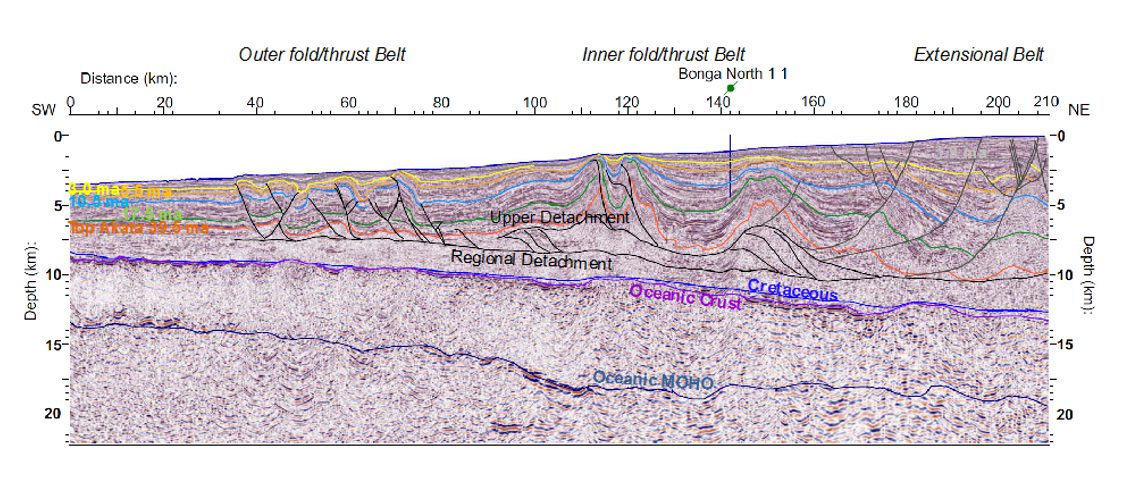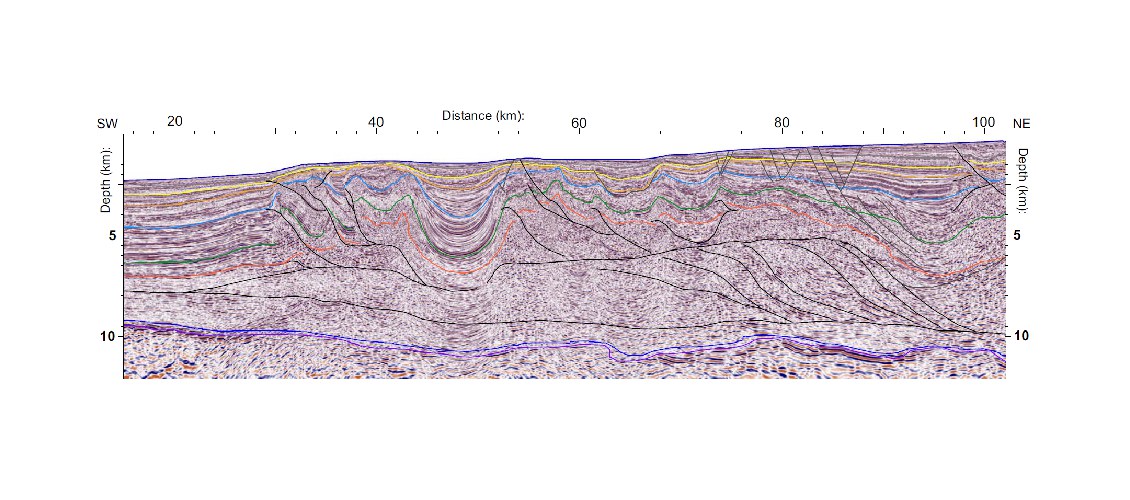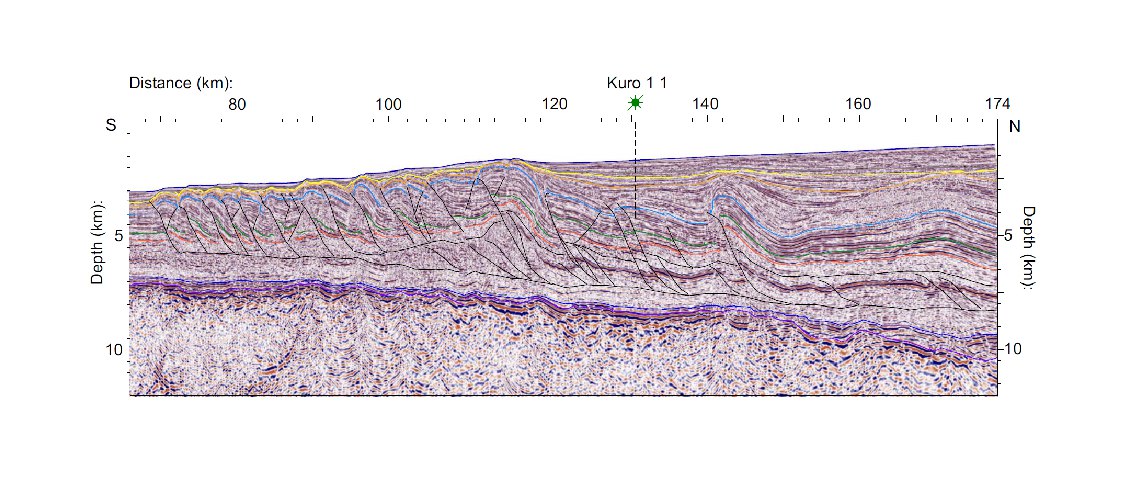The Niger Delta system (Figure 1) is one of the world’s largest Tertiary deltas and one of its most prolific hydrocarbon systems, containing an estimated 68 Bboe and producing approximately 3 MMboe per day. The evolution of the delta has created an almost perfect petroleum system with the thick Akata shale oil-prone source rock overlain by a substantial succession of progressively shallower facies in a sand-prone delta system. The load of the thick delta rocks causes gravitational collapse on the underlying, overpressured Akata shale, forming structural traps in both up-dip extensional and down-dip contractional systems (Figure 2). As always though, the devil is in the detail, and the complex relationship between timing of maturation and timing of structuration in the different structural domains creates exploration risk and the need to understand the development of the system as a whole. ION’s NigeriaSPAN data is being used to pull together this integrated story.
The Niger Delta prograded into the South Atlantic during the Cenozoic, after break-up in the Albian/Aptian (Figure 1). The fit of the South American continent demonstrates the entire offshore area has to be underlain by Cretaceous oceanic crust. During break-up, several rift basins opened in Central Africa and these topographic lows have focussed sediment flux and deposition into the Niger Delta area since that time.
Quality Data Important
 Figure 3: NigeriaSPAN layout over structural elements map with location of displayed seismic lines. Bathymetric map from Corredor et al. 2005 AAPG Bulletin, v. 89, no. 6.A key to making a full evaluation of the Niger delta system has been the availability of long-offset (10km), long-record (18s TWT), regional seismic data that have been pre-stack depth migrated. Many of the NigeriaSPAN lines were also acquired using a deep-towed cable and source, which also helps to improve image quality. Beyond careful planning and acquisition, the use of ION GXT’s latest imaging and velocity modelling capabilities has provided the results seen here. Depth imaging enables the interpreter to view complex structures with true depth perspective and to see the regional links between the different provinces.
Figure 3: NigeriaSPAN layout over structural elements map with location of displayed seismic lines. Bathymetric map from Corredor et al. 2005 AAPG Bulletin, v. 89, no. 6.A key to making a full evaluation of the Niger delta system has been the availability of long-offset (10km), long-record (18s TWT), regional seismic data that have been pre-stack depth migrated. Many of the NigeriaSPAN lines were also acquired using a deep-towed cable and source, which also helps to improve image quality. Beyond careful planning and acquisition, the use of ION GXT’s latest imaging and velocity modelling capabilities has provided the results seen here. Depth imaging enables the interpreter to view complex structures with true depth perspective and to see the regional links between the different provinces.
This improved imaging allows one to see detail in places within the mobile shale structures, which can help constrain the extent of brittle vs. ductile deformation (Figures 4 and 5). What may previously have been interpreted as shale structures with a diapiric origin are at once transformed into low angle shale-cored thrust sheets. What has been interpreted as a single mobile Akata shale formation becomes layered sequences of shale bodies with differing mobilities separated by regional detachment zones that are fundamental to the present-day structural shape of the offshore Niger Delta.
The Main Play
Initial offshore exploration was an extension of the onshore successes in a shallow water region with a continuation of the extensional, growth fault structural regime (Figure 3). Large listric faults with throws mainly down to the basin (SW) provided a rich environment for structural traps within the Lower Miocene and younger stratigraphy (Figure 2). Successes came thick and fast with a string of mediumsized oil, gas and condensate fields discovered along this coastal belt.
During the past decade drilling has progressed into deep water, to 2,000m and beyond in the inner fold and thrust belt, with several major discoveries. Among these are Bosi, Agbami and Nnwa, all associated with a thick (>100m) Akata source rock and with production from often stacked deepwater turbidite reservoirs of Upper Miocene age. Reservoirs are often of very high quality and acoustic effects of fluids are often visible on seismic. The structures of the inner fold and thrust belt have been difficult to image in past datasets, showing only thick sections of seismically opaque facies commonly interpreted as shale ‘diapirs’ with only thin sediments. Deep-tow data here reveals several deep areas of stacked thrust sheets, within the Paleogene strata (Figures 2 and 4), with associated floor and roof detachments interpreted throughout the delta.
New Plays, New Risks
To continue to grow the resource of the Niger Delta, new plays must be proven and demonstrated to be economic. The old adage to ‘go deeper’ applies in two senses: extending exploration out to the deeper water and the outer fold belt, and exploring the deeper stratigraphy in the proven areas. Both carry challenges and risks, but offer huge potential.
Early exploration in the deep water between 2002 and 2005 proved disappointing and much less successful than earlier efforts in the shallower parts of the delta. Exploration from 2005 through 2009 was somewhat more successful with a string of finds in the southern part of the delta (Pina, Etan, Zabazaba and Kuro). All of these discoveries are on the inboard side of the outer fold and thrust belt, and highlight some of the key risks in this play where only a significant sized accumulation will prove economic. These risks include:
• Maturation and source potential: The thinner sediment package in the outboard clearly limits maturation – this means maturation is probably more recent. Also, the Akata shale unit clearly thins as well, decreasing total potential.
• Migration: If detachment faults act as any kind of barrier to migration then the outer fold and thrust belt can only directly access a much thinner section of source than the inner belt. This means the outer belt may be more dependent on longer distance migration.
• Timing of trap formation: The outer fold belt is a younger feature than the inner belt (compare Figures 4 and 5) and will only trap the most recent migrated hydrocarbons.
Successful deeper drilling within the established inner fold and thrust belt relies on identification of reservoirs through good imaging. Figure 4 demonstrates the clear presence of reservoir character stratigraphy at lower Miocene levels, and these targets are gradually being exploited but remaining potential is high.
Further potential also exists in defining combined structural/stratigraphic traps on mobile shale structures. Several successful wells have targeted this play, such as the Bonga field (Figure 2). Structural development occurred throughout the Miocene, sometimes continuing to the present day, and the associated pinch-outs have largely been ignored. Ultimately they will provide a rich if somewhat more uncertain harvest.
The NigeriaSPAN data have been used to image two major detachments within the Akata shale that have not previously been imaged, which appear to control the overlying structural development. The upper detachment is constrained to the inner fold and thrust belt, and the lower detachment underlies both inner and outer fold and thrust belts (the outer being the younger of the systems). By post-Cretaceous times, basement tectonic control had ceased to be an influence on the overall morphology; the South America plate had long since departed. What remains to control the structural evolution is sediment loading and mobile Akata shale, and to understand the twinned thrust belts requires high quality imaging of this formation across the whole system. The deposition, burial and deformation of this unit appear to control the success of the various petroleum plays.








